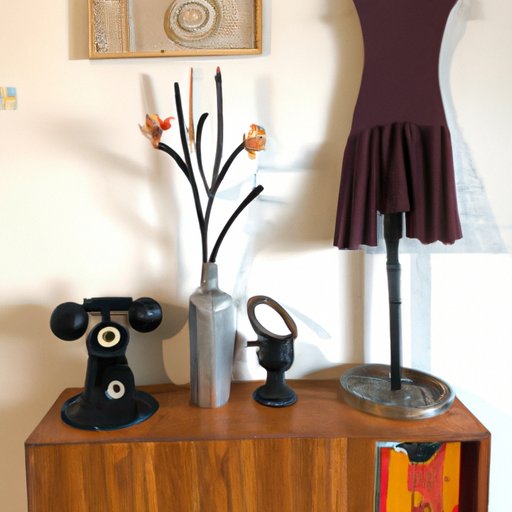Introduction
The term “vintage” refers to items that are at least 20 years old, but can often refer to items that are as much as 100 years old or more. Vintage style and decor has become increasingly popular in recent years, as people seek to bring a unique, timeless aesthetic to their homes and wardrobes. There are many benefits to embracing vintage style, such as the ability to reduce waste by reusing and repurposing older items, and the ability to create one-of-a-kind looks that reflect your own personal style.
A Comprehensive Guide to Vintage Style and Decor
Whether you’re looking to add some vintage flair to your wardrobe or your home, there are a few things you should know about vintage style and decor. Here’s a comprehensive guide to help you get started.
Identifying True Vintage Clothing
When shopping for vintage clothing, it’s important to be able to recognize genuine vintage items from modern reproductions. Here are some tips for recognizing vintage items:
- Look for labels or tags that indicate the item was made before 1990.
- Check for signs of wear and tear, such as discoloration, fading, and fraying.
- Inspect the seams and stitching for any irregularities.
- Familiarize yourself with the silhouettes and details of vintage styles.
It’s also important to differentiate between vintage and modern styles. While modern clothing often features bold colors and patterns, vintage clothing typically has a more muted color palette and simpler design elements. Additionally, vintage clothing often has unique details such as pleats, ruffles, and buttons, which can help you identify an item as being vintage.
Exploring the History of Vintage Fashion
To truly appreciate vintage style, it’s helpful to explore the history of vintage fashion. Notable vintage fashion trends include the flapper style of the 1920s, the glamorous Hollywood look of the 1950s, and the mod style of the 1960s. Many of these trends have been revived and reimagined in modern fashion, showing the lasting influence of vintage fashion.
In addition to iconic fashion trends, vintage fashion is also associated with notable designers such as Coco Chanel, Christian Dior, and Yves Saint Laurent. These designers pioneered iconic looks that remain popular today, making them a valuable source of inspiration for anyone interested in vintage style.
Shopping for Vintage Clothing: Tips & Tricks
When shopping for vintage clothing, it’s important to know where to look and how to shop. Here are some of the best sources for finding vintage clothing:
- Online stores – There are numerous online shops that specialize in vintage clothing, making it easy to find unique pieces from the comfort of your own home.
- Local thrift shops and consignment stores – Thrift stores and consignment stores are great places to find affordable vintage clothing, as well as other used items.
- Flea markets and vintage boutiques – Flea markets and vintage boutiques are excellent sources of one-of-a-kind vintage items, though they may require some digging to uncover hidden gems.
When shopping for vintage clothing, it’s important to consider condition, fit, and quality. Inspect the item carefully and ask questions if necessary. It’s also important to know your measurements, as vintage clothing may not always match modern sizing standards. Finally, do your research before making a purchase to ensure you’re getting a good deal.
Crafting with Vintage Materials
One of the most rewarding aspects of vintage style is the ability to craft with vintage materials. Popular crafts using vintage materials include upcycling and repurposing old clothes into new garments, crafting jewelry from vintage beads and buttons, and making home decor from vintage fabric scraps.
When working with vintage materials, it’s important to handle them with care. Delicate fabrics may need to be washed separately and line dried. Additionally, researching proper cleaning techniques and utilizing pattern guides and tutorials can help make the crafting process easier.

The Rise of the Vintage Home Decor Trend
Vintage style isn’t just limited to clothing—it’s also becoming increasingly popular in home decor. Popular vintage decor pieces include mid-century furniture, antique china and glassware, and retro light fixtures. Incorporating vintage elements into your home can help you create a unique, timeless look that reflects your own personal style.
When incorporating vintage elements into your home, it’s important to mix and match vintage pieces with modern décor. Incorporate vintage prints and patterns into your space, and don’t be afraid to repurpose old furniture and accessories. With a little bit of creativity and imagination, you can transform your home into a stylish, vintage-inspired oasis.
Conclusion
Vintage style and decor is a great way to add a unique, timeless aesthetic to your wardrobe and home. By following this comprehensive guide, you can learn how to identify true vintage items, find sources for vintage clothing, and incorporate vintage elements into your home. Whether you’re shopping for vintage clothing or crafting with vintage materials, you can create looks that are sure to turn heads and last a lifetime.


